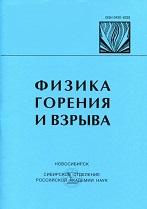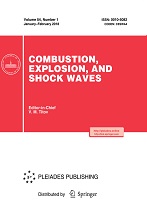|
This article is cited in 51 scientific papers (total in 51 papers)
Heat fluxes to combustor walls during continuous spin detonation of fuel-air mixtures
F. A. Bykovskii, E. F. Vedernikov
Lavrent’ev Institute of Hydrodynamics, Siberian Division, Russian Academy of Sciences, Novosibirsk, 630090, Russia
Abstract:
Pioneering measurements of heat fluxes to the walls of flow-type combustors of different geometries were performed in regimes of continuous spin detonation of fuel-air mixtures under unsteady heating. These heat fluxes are compared with those observed in the regime of conventional turbulent combustion in the same combustor. Air is used as an oxidizer, and acetylene or hydrogen is used as a fuel. For identical flow rates of the fuel, the heat fluxes to the combustor walls in regimes of continuous spin detonation and conventional combustion are close to each other; their mean steady values are $\approx$1 MW/m$^2$ ($\approx$0.5% of the enthalpy flux of the products over the channel cross section). In both detonation and combustion regimes, the maximum heat fluxes penetrate into the walls in the mixing region (where the heat release occurs). In the case of detonation, regenerative cooling of the combustor walls by the flow of the fresh mixture occurs in the heat-release region (region of propagation of the detonation-wave front). The regeneration becomes less effective in the downstream direction because of the shorter time of contact between the walls and the cold mixture and a longer time of contact between the walls and the hot products. More intense heating persists downstream of the front, where the regeneration ceases, but the temperature of the products is high. The character of heating of the wall in the region of rotation of the front of spin detonation waves depends on the number of these waves: the zone of the maximum heat release becomes narrower with increasing number of waves.
Keywords:
continuous spin detonation of the fuel, flow-type combustor, fuel-air mixtures, heat fluxes to the walls.
Received: 17.12.2007
Accepted: 22.07.2008
Citation:
F. A. Bykovskii, E. F. Vedernikov, “Heat fluxes to combustor walls during continuous spin detonation of fuel-air mixtures”, Fizika Goreniya i Vzryva, 45:1 (2009), 80–88; Combustion, Explosion and Shock Waves, 45:1 (2009), 70–77
Linking options:
https://www.mathnet.ru/eng/fgv1262 https://www.mathnet.ru/eng/fgv/v45/i1/p80
|


| Statistics & downloads: |
| Abstract page: | 27 |
|





 Contact us:
Contact us: Terms of Use
Terms of Use
 Registration to the website
Registration to the website Logotypes
Logotypes








 Citation in format
Citation in format 
